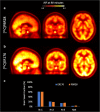Parametric Mapping for TSPO PET Imaging with Spectral Analysis Impulsive Response Function
- PMID: 33475944
- PMCID: PMC8277653
- DOI: 10.1007/s11307-020-01575-9
Parametric Mapping for TSPO PET Imaging with Spectral Analysis Impulsive Response Function
Abstract
Purpose: The aim of this study was to investigate the use of spectral analysis (SA) for voxel-wise analysis of TSPO PET imaging studies. TSPO PET quantification is methodologically complicated by the heterogeneity of TSPO expression and its cell-dependent modulation during neuroinflammatory response. Compartmental models to account for this complexity exist, but they are unreliable at the high noise typical of voxel data. On the contrary, SA is noise-robust for parametric mapping and provides useful information about tracer kinetics with a free compartmental structure.
Procedures: SA impulse response function (IRF) calculated at 90 min after tracer injection was used as main parameter of interest in 3 independent PET imaging studies to investigate its sensitivity to (1) a TSPO genetic polymorphism (rs6971) known to affect tracer binding in a cross-sectional analysis of healthy controls scanned with [11C]PBR28 PET; (2) TSPO density with [11C]PBR28 in a competitive blocking study with a TSPO blocker, XBD173; and (3) the higher affinity of a second radiotracer for TSPO, by using data from a head-to-head comparison between [11C]PBR28 and [11C]ER176 scans.
Results: SA-IRF produced parametric maps of visually good quality. These were sensitive to TSPO genotype (mean relative difference between high- and mixed-affinity binders = 25 %) and TSPO availability (mean signal displacement after 90 mg oral administration of XBD173 = 39 %). Regional averages of voxel-wise IRF estimates were strongly associated with regional total distribution volume (VT) estimated with a 2-tissue compartmental model with vascular compartment (Pearson's r = 0.86 ± 0.11) but less strongly with standard 2TCM-VT (Pearson's r = 0.76 ± 0.32). Finally, SA-IRF estimates for [11C]ER176 were significantly higher than [11C]PBR28 ones, consistent with the higher amount of specific binding of the former tracer.
Conclusions: SA-IRF can be used for voxel-wise quantification of TSPO PET data because it generates high-quality parametric maps, it is sensitive to TSPO availability and genotype, and it accounts for the complexity of TSPO tracer kinetics with no additional assumptions.
Keywords: PET; Parametric mapping; Spectral analysis; TSPO.
© 2021. The Author(s).
Conflict of interest statement
The authors declare that they have no conflict of interest.
Figures




Similar articles
-
Parametric mapping using spectral analysis for 11C-PBR28 PET reveals neuroinflammation in mild cognitive impairment subjects.Eur J Nucl Med Mol Imaging. 2018 Jul;45(8):1432-1441. doi: 10.1007/s00259-018-3984-5. Epub 2018 Mar 9. Eur J Nucl Med Mol Imaging. 2018. PMID: 29523926 Free PMC article.
-
11C-ER176, a Radioligand for 18-kDa Translocator Protein, Has Adequate Sensitivity to Robustly Image All Three Affinity Genotypes in Human Brain.J Nucl Med. 2017 Feb;58(2):320-325. doi: 10.2967/jnumed.116.178996. Epub 2016 Nov 17. J Nucl Med. 2017. PMID: 27856631 Free PMC article.
-
Head-to-head comparison of 11C-PBR28 and 11C-ER176 for quantification of the translocator protein in the human brain.Eur J Nucl Med Mol Imaging. 2019 Aug;46(9):1822-1829. doi: 10.1007/s00259-019-04349-w. Epub 2019 May 31. Eur J Nucl Med Mol Imaging. 2019. PMID: 31152207
-
Have (R)-[11C]PK11195 challengers fulfilled the promise? A scoping review of clinical TSPO PET studies.Eur J Nucl Med Mol Imaging. 2021 Dec;49(1):201-220. doi: 10.1007/s00259-021-05425-w. Epub 2021 Aug 13. Eur J Nucl Med Mol Imaging. 2021. PMID: 34387719 Free PMC article.
-
Kinetic modeling and parameter estimation of TSPO PET imaging in the human brain.Eur J Nucl Med Mol Imaging. 2021 Dec;49(1):246-256. doi: 10.1007/s00259-021-05248-9. Epub 2021 Mar 11. Eur J Nucl Med Mol Imaging. 2021. PMID: 33693967 Free PMC article. Review.
Cited by
-
Kinetic evaluation and assessment of longitudinal changes in reference region and extracerebral [18F]MK-6240 PET uptake.J Cereb Blood Flow Metab. 2023 Apr;43(4):581-594. doi: 10.1177/0271678X221142139. Epub 2022 Nov 24. J Cereb Blood Flow Metab. 2023. PMID: 36420769 Free PMC article.
-
A crosstalk between gut and brain in sepsis-induced cognitive decline.J Neuroinflammation. 2022 May 23;19(1):114. doi: 10.1186/s12974-022-02472-4. J Neuroinflammation. 2022. PMID: 35606817 Free PMC article.
References
-
- Herrera-Rivero M, Heneka MT, Papadopoulos V. Translocator protein and new targets for neuroinflammation. Clin Transl Imaging. 2015;3(6):391–402. doi: 10.1007/s40336-015-0151-x. - DOI
Publication types
MeSH terms
Substances
Grants and funding
LinkOut - more resources
Full Text Sources
Other Literature Sources
Medical

